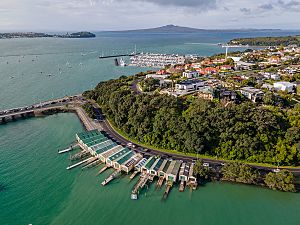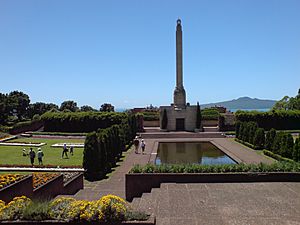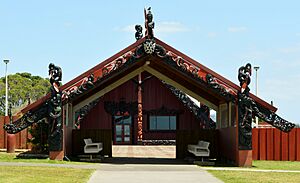Ōrākei facts for kids
Quick facts for kids
Ōrākei
|
|
|---|---|
|
Suburb
|
|

View from Hobson Bay looking northeast over Ōrākei towards Rangitoto Island
|
|
| Country | New Zealand |
| Local authority | Auckland |
| Electoral ward | Ōrākei ward |
| Local board | Ōrākei Local Board |
| Area | |
| • Land | 310 ha (770 acre) |
| Population
(June 2023)
|
|
| • Total | 5,800 |
| Train station(s) | Ōrākei railway station |
|
|
||

Ōrākei is a suburb of Auckland city, in the North Island of New Zealand. It's on a peninsula about 5 kilometres east of Auckland's city centre. Ōrākei is surrounded by water on three sides: the Waitematā Harbour to the north, and Hobson Bay and Ōrākei Basin to the west and south. To the east is the suburb of Mission Bay. A special coastal area called Takaparawhau / Bastion Point is also in Ōrākei, near Ōkahu Bay.
About Ōrākei
The name Ōrākei comes from the Māori words meaning "place of adornment."
Takaparawhau / Bastion Point is home to the Ōrākei Marae. A marae is a special meeting place for Māori people. The meeting house there is called Tumutumuwhenua. This marae is a traditional gathering place for the Ngāti Whātua iwi (tribe) and their Ngāti Whātua Ōrākei, Ngā Oho, Te Taoū and Te Uri hapū (sub-tribes). In the 1940s, the Ōrākei pā (village) was one of the last places where traditional kūmara (sweet potato) plants were grown.
Takaparawhau / Bastion Point also has a memorial for Michael Joseph Savage. He was New Zealand's first Labour Party prime minister of New Zealand. He was very popular and died while in office in 1940. The memorial was opened in 1943 and has great views of the Waitematā Harbour.
Ōrākei's History
The Ōrākei area has always been important to the Ngāti Whātua Ōrākei people. Before New Zealand was settled by Europeans, this land was vital for fishing and farming. Over many years, from the 1840s to the 1950s, the New Zealand Government took much of this land. They said it was for public works and development.
Ōrākei was also the first place where the New Zealand Flying School operated. This was in late 1915, before the school moved to other locations.
The Bastion Point Protest
In the 1970s, the government planned to sell Bastion Point for new houses. The Ngāti Whātua Ōrākei people and others formed the Ōrākei Māori Action Committee. They wanted to stop the land from being sold.
From 1977 to 1978, the committee organised a peaceful occupation of the land. This protest lasted for 506 days. The occupation and how it ended helped show people the unfairness Māori faced. It became a very important event in the Māori protest history.
In 1988, the New Zealand Labour Government returned Takaparawhau / Bastion Point and Ōrākei Marae to Ngāti Whātua Ōrākei. This was part of a Treaty of Waitangi settlement.
Today, parts of Takaparawhau, including the marae, are reserved for Ngāti Whātua Ōrākei. Other areas, like Ōkahu Reserve, are called Whenua Rangatira. These lands are for the use of both the hapū members and the people of Auckland. They are managed by a special board with members from Ngāti Whātua Ōrākei and the Auckland Council.
Ōrākei Today
Ōrākei covers about 3.10 square kilometres. As of 2023, it has an estimated population of about 5,625 people.
In the 2018 census, there were 5,625 people living in Ōrākei. About 16.2% of the people were under 15 years old.
Most people in Ōrākei are of European descent (70.3%). There are also many Māori (18.8%), Asian (13.9%), and Pacific peoples (6.9%). About 30.4% of people were born overseas.
Education
Ōrākei has several schools:
- Selwyn College is a secondary school for students in years 9–13.
- Ōrākei School is a primary school for students in years 1–8.
- St Joseph's School is a state-integrated Catholic primary school for students in years 1–8.
All these schools are co-educational, meaning both boys and girls attend.



